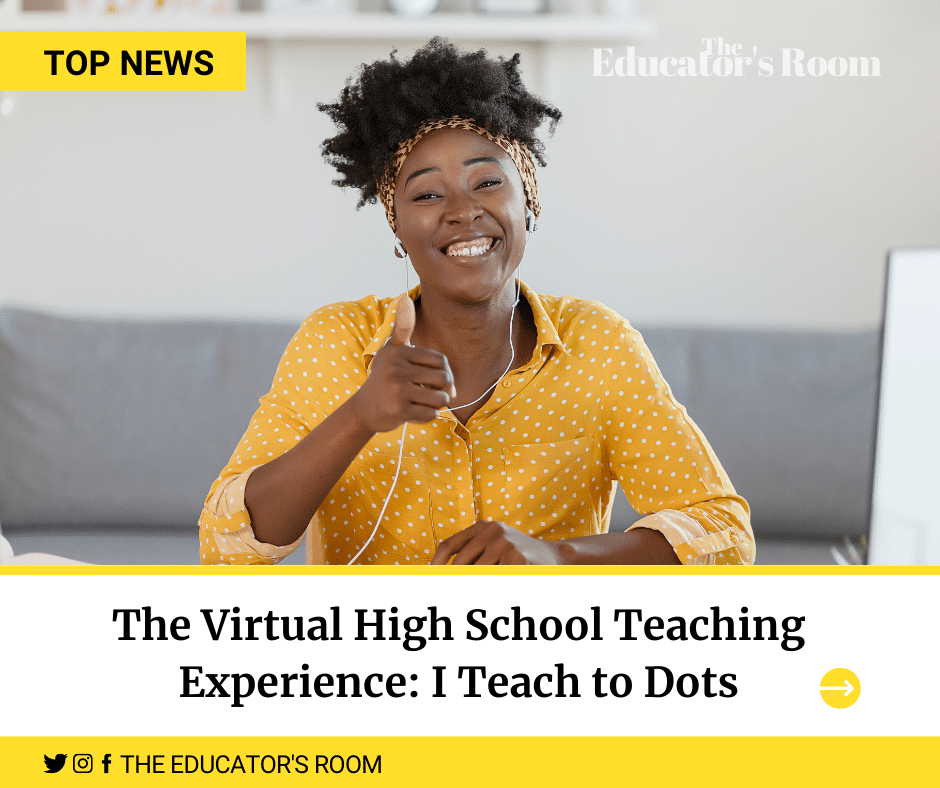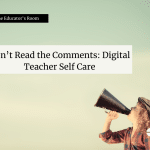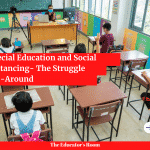Guest Writer: Leann Wnuk Ed.S.
Leann is currently a high school Special Education teacher with over 10 years of experience in multiple states and grade levels. I have an Ed.S. in Special Education, an M.S. in Special Education, and a B.A. in Middle Grades Language Arts and Social Studies.
I show up to the computer, coffee in my hand, ready to educate tomorrow’s leaders. While I may be teaching virtually, I still search the closet for an acceptable teacher shirt and switch out of my pajama pants for something more acceptable. While I may not be dressed in a skirt or heels, I still show up, ready to go, but I can not say the same about my students.
In fact, I don’t know what they wear or even what they look like. As a high school teacher in the virtual Covid world, they are all a big black sea of endless dots. Some pink, some blue, some with a graphic, but if you asked me to pick one of my students out of a line-up, I couldn’t.
Some elementary teachers would argue this is a good thing. I also teach a special education reading class to the students on the life-skills track. There, the students are all camera, smiles, and an abundance of ¨Ms. Wnuk look at this,¨ as they hold up their protesting cat, dog, and hairless rat. While the distractions are endless in that class, we are a team in that virtual space. A group of small squares that make for a whole class family-like environment.
However, in my inclusion classes, we are all just strangers. We are dots. I teach to the soulless void of dots. While elementary teachers may see this as bliss, my high school colleagues are feeling hopeless, as the lack of connection drains their energy like a black hole. Their questions echo into the abyss, and often go unanswered. Sometimes they wonder if their microphone is muted, then they realize it is not. The students are just not willing to engage. The disconnect is discouraging, and it is a far cry from the classroom environments they have successfully built in the past.
So what is one to do when the abyss is so lonely? When your hard planned lessons are received with the silence of the unknown dots. Here are a few things many schools and my colleagues have tried, as they try to turn the lights on in their virtual classrooms.
Negative Consequence
In this scenario, teachers offer participation points toward their grades. If they have it on, they get a good grade, and if they do not, they lose points. From my experience, especially with my special education students and other behavioral students, they cannot afford to lose points for non-academic reasons. They are barely maintaining a passing grade as it is, if not already failing. It is the kids who need the points the most that will refuse to do it. In the end, I feel that this only hurts their grade. I personally don’t want their grades to suffer any more than it already has in this Covid learning world.
The Positive Reinforcement
In one of my inclusion classes, we tried to implement extra credit points for having your camera on. Our system was to add bonus points to their grade. I have also had discussions with teachers who use a weekly raffle entry or homework passes for those that put it on. Unfortunately, my experience with this tactic is much like the first. It was the A students, the ones who didn’t need the points that put their cameras on. Those who needed the extra credit still did not participate. Their buy-in was not existent. After all, many of the low-achieving students aren’t self-regulated enough to care about their grades and they had little buy-in. A better grade was not enough motivation. They cared more about their appearance, video games, or sleeping, and had little buy-in for a grade boost.
Attendance
I have seen school districts that support marking a student absent if they do not have their video on. With the administration supporting these efforts, it may be feasible. However, my district isn’t one of them. As a result, I cannot mark them absent and I am not sure I would want to. In the end, they are there, which I feel is a big part of the battle in virtual learning. Additionally, schools may have a harder time mandating an attendance policy during the Covid year and they are waiving the policies of the past.
At the beginning of the year, my co-teacher and I tried to have them put the camera on at the beginning for attendance. We marked a lot of ceilings, lamps, foreheads, and pillows present for the day. They quickly turned them off after attendance and at the end of the class, there was still that lone virtual dot that was not responsive, who did not leave the meet when class was dismissed and we had to manually remove them. We realized this was fruitless and was time-consuming. As we gained access to an attendance extension, we stopped it all together.
Interactive
At the High School level, this may work but only to a degree. Many teachers have tried the interactive assignments. The brain breaks, scavenger hunt, treasure hunters, Simon Says game style teachers. I have not tried this at this level. I feel the lack of engagement will be disheartening and the students will only complain about the lack of effectiveness the lesson is having. After all, is it to teach the material, or is it only to see their faces. I feel my student population will quickly spot this lesson as arouse. Additionally, I do not foresee the ones who need it participating.
Alternative Measures
After attempt after an attempt had failed me, I have found alternative measures to measure classroom engagement. These are the ones I have found most successful.
-
Nearpod/Pear Deck: Using these programs, you can monitor student responses in live time. You know if a student is answering questions and if they understand the material.
-
Go Guardian: My district has incorporated this to monitor a student’s screen. This is only available if students are on a school device with their school email. This has been great for monitoring on-task behavior. I can close tabs, private message them, and more!
-
The Chat Box: I have found that asking students to respond to class discussions in the chatbox makes students more likely to participate. They do not have to speak in front of the group, they can take turns and not talk over each other, and they are able to participate in class discussions.
Picking Your Battles
To force the camera on or not to force the camera on, that is the question. One thing I have learned over my years of teaching, which has kept me in this profession, is to pick my battles. Early on, I realized, this was a battle that I wasn’t going to win. In the pandemic world, we have all had to adapt and be flexible in so many areas of life, and this is one of them.
After speaking privately with many students, I have realized that many of the students have valid reasons for not wanting their cameras on. Some are self-conscious, others are embarrassed by their environment beyond that of a dirty room, some are ashamed of family members, some share a room with multiple siblings, some just woke up, some haven’t been able to get a haircut in months and so on. If you listen to them, their reasoning is justified.
Furthermore, some could argue that it is a privacy violation. This is their private home, one that they don’t necessarily have control over. We should not force students, who are not in charge of the space, to share it.
Lastly, in the age of Snapchat, Instagram, and TikTok, anyone can be filming, snapping, and sharing videos and images of your class. Many students may know this and with fear of being ridiculed, may opt-out of sharing their image.
In the end, I feel that this should be your personal judgment based on your individual students. There is not a one size fits all solution to this problem. I think the solution is to listen to your students’ needs, make good personal judgment calls on a case by case basis, and be flexible. In the end, I lost the battle and I am okay with it. I have found other techniques to monitor on-task behavior. You just have to find out what works best for your class.






